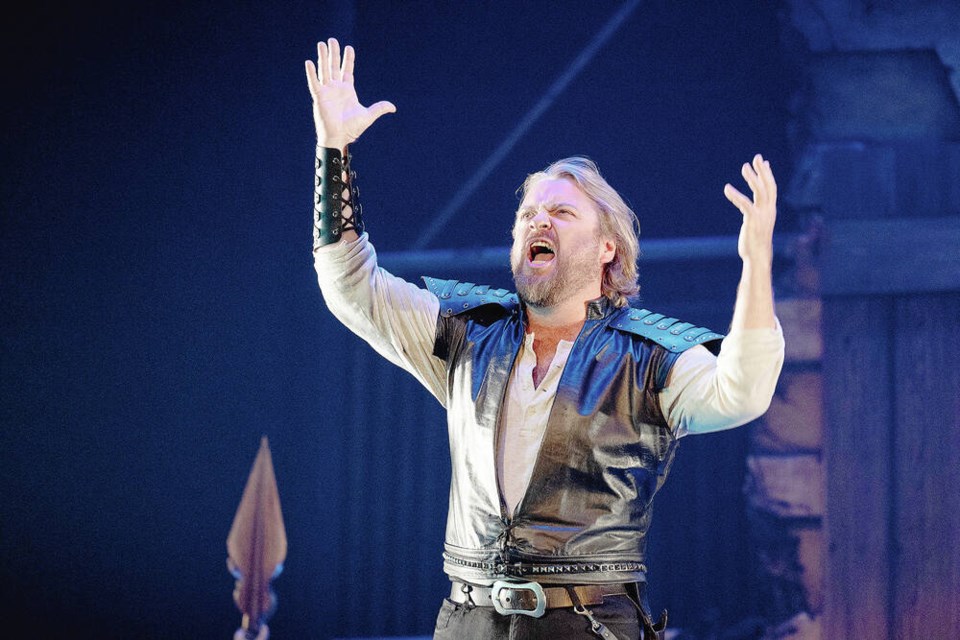It’s early days. Yet surely Pacific Opera Victoria’s richly ambitious production of Die Walküre will emerge as the highlight of the arts season.
Simply put, this sprawling German smorgasbord is nothing short of spectacular. Yes, yes, we all know it’s long. Five hours, if you include two intermissions. This is not opera — or more accurately, “music drama” — for the faint of heart.
Do not be intimidated. This Die Walküre will yank you into its strange, glittering, unearthly world and never let you go. So take that power nap beforehand. And yes, if you must, pre-order a cheese plate to nibble at intermissions (you can actually do this). Just make sure you go.
Why? Well, Die Walküre’s got it all. Vain and deceitful gods at battle. Lustful twins declaring their non-platonic love. Swords fall out of the sky, drugged cocktails are swigged, warrior maidens gallop gleefully and flames flicker fitfully around sleeping beauties.
This is a feisty, imaginative production with a strong cast who on Thursday night successfully melded Wagnerian heft with a welcome sensitivity and humanity. The action moved with leisurely deliberation and yet — despite the length — the performance was never ponderous or boring.
Of Wagner’s Der Ring des Nibelungen (the Ring tetralogy), Die Walküre is most often staged as a stand-alone. It’s a massively ambitious project for any organization, especially for a regional opera such as POV, mounting it here for the first time.
Die Walküre is the company’s largest production to date, breaking a previous budget record set by Il Trittico in 2019. The original score calls for a 120 musicians. Such a throng would never shoehorn into the Royal Theatre’s small pit; therefore, the POV uses a reduced Abbass adaptation with a 49-piece orchestra.
On opening night there was drama off-stage as well as on. Staging operas from the Ring Cycle has been a long-time ambition of conductor Timothy Vernon (the driving force behind POV’s Das Rheingold in 2014). Unfortunately Vernon injured his back shortly before the performance. So, at short notice, associate conductor Giuseppe “Joey” Pietraroia stepped in — very ably.
The action in Die Walküre centres around a ruined mansion symbolic of a universe tipped off balance. It’s a dystopian society set in some futuristic time. The singers wear costumes that blend Game of Thrones with a touch of modern. For instance, Siegmund (Viktor Antipenko) has flowing locks, a fur-timmed cape, a black leather vest and something that looked suspiciously like a wallet chain. He might pass for a Viking or a groovy-looking biker.
Antipenko provided some of the night’s best singing. His unforgettable sustained notes in Act I (the so-called “Wälse calls” as Siegmund summons his father) radiated a strange ethereal beauty. A handsome tenor able to summon robust heft when required, Antipenko mined the nuance and delicacy within the role. Siegmund’s complexity was fully revealed.
Based on Norse mythology, Die Walküre sparks dramatic conflict by pitting gods against humans. Part of Wagner’s genius lies in the complexity of his characters, be they supreme beings or mere mortals. Most are flawed and contorted with self-doubt … just like real people.
The all-powerful god Wotan bickers with his goddess wife Fricka and is browbeaten into letting his beloved son Siegmund die in battle. Meanwhile “bride-sister” Sieglinde is (sort of) fine with having the incestuous hots for Siegmund, but is twisted with guilt over breaking her marriage vows.
The immense role of Wotan was well performed by baritone Mark Delavan, a Wagner veteran who sang and acted with authority. Among his finest moments was an extended Act III scene with the equally impressive soprano Jennifer Maines, playing his daughter Brüunhilde. Maines, looking sportif in a mini-skirt and knee-high boots, played the disobedient Valkyrie with puckish verve. An early scene in which Brüunhilde explains to Siegmund that he must perish was notable for her keening high notes of an unearthly beauty.
Fine singing was in evidence throughout. Mezzo-soprano Allyson McHardy, a potent Fricka, combined a lush sound with impressive acting chops. Bass Simon Wilding is a suitably despicable Hunding. As Sieglinde, soprano Aviva Fortunata revealed a wonderfully rounded — even creamy — timbre, yet managed to be easily heard over the mega-watt fury of the Valkyries’ chorus.
This Valkyrie sequence in Act III was the evening’s most exciting, a real tour de force for stage director Glynis Leyshon and the design team. It commenced with a black-hooded figure spray-painting graffiti onto the derelict mansion. Thanks to a clever projection, the outline of a horse transforms into a moving 3-D animal — a spectacular theatrical trick.
The Valkyrie sisters then enter bellowing war cries on their steeds (supernumeraries in horse masks). With their shields and BDSM-style leather-and-metal costumes, they looked like a kick-ass girl band that means business. They sounded fantastic — projecting with such Amazonian power one almost needed ear plugs.
With Wagner’s notion of the music drama there’s greater emphasis on serving the story (as opposed to recitative acting mostly as a frame for showy arias, as is typical of Italian opera). The orchestra has a more significant role in terms of narrative — it’s more firmly interwoven into the action; characters are represented by numerous leitmotifs.
The Victoria Symphony navigated a difficult score quite well. Missteps were few, perhaps one or two lugubrious brass passages. Overall the playing was well-modulated, bringing out the intricacies of the music. At its best the orchestral sound was a pure reflection — a musical mirror — into the minds of the characters.
Die Walküre continues for three performances: Oct. 15 at 12:30 p.m, and Oct. 18 and 21 at 6 p.m.
>>> To comment on this article, write a letter to the editor: [email protected]



